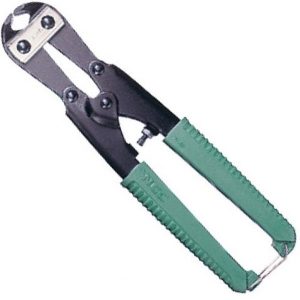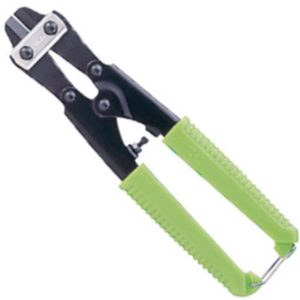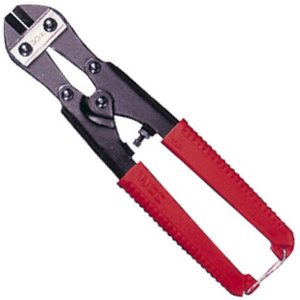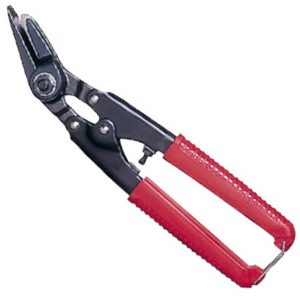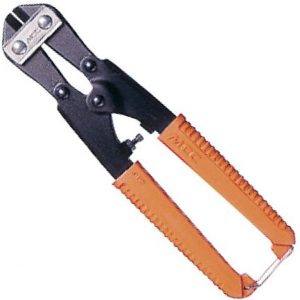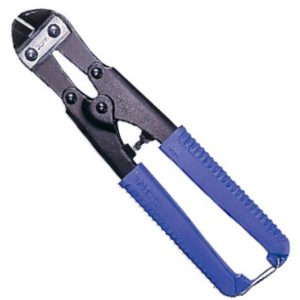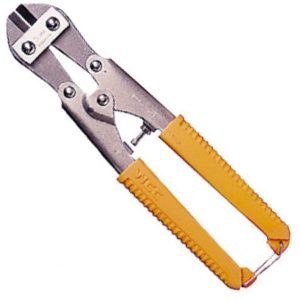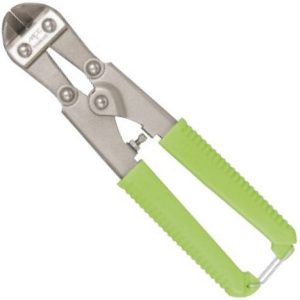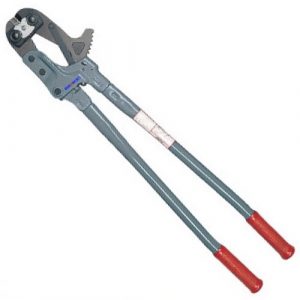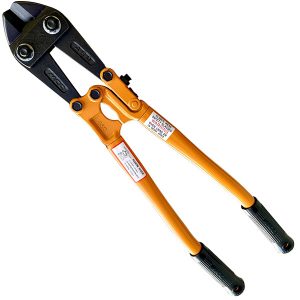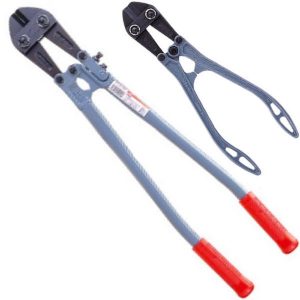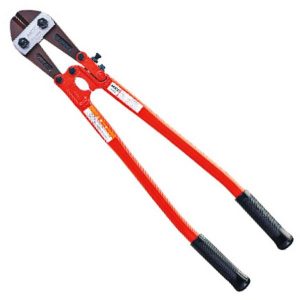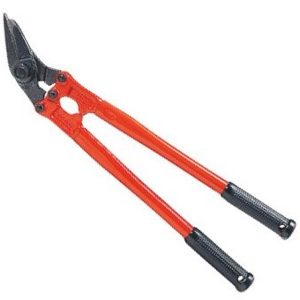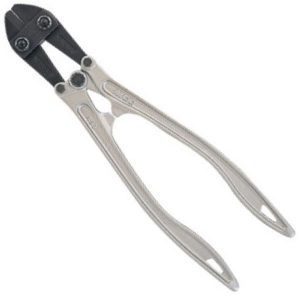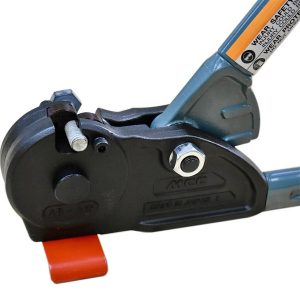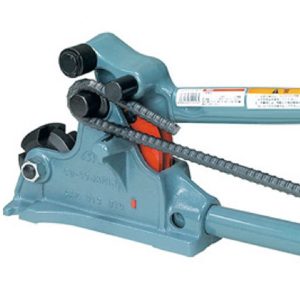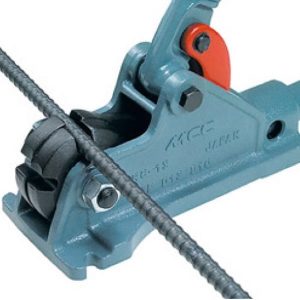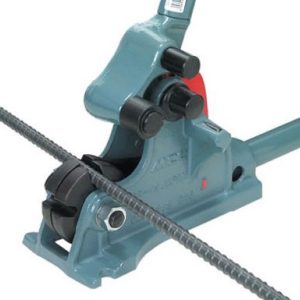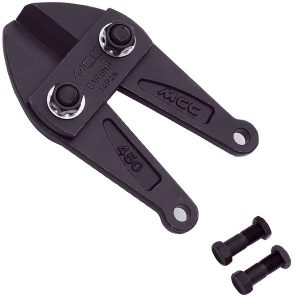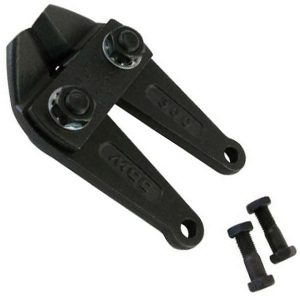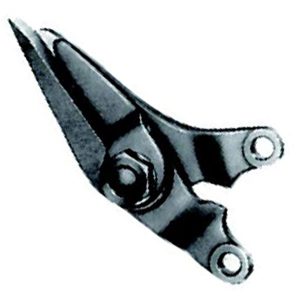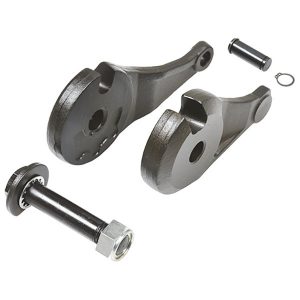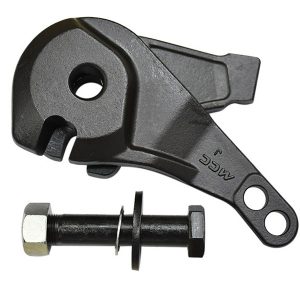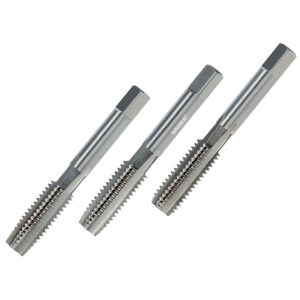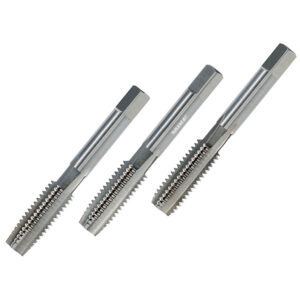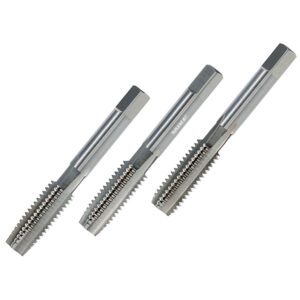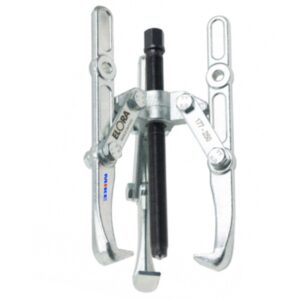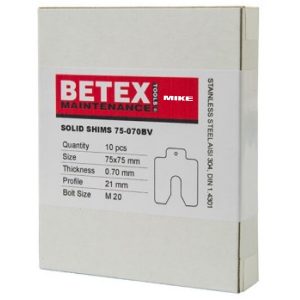A bolt cutter is a hand tool used to cut through metal objects, particularly bolts, chains, and padlocks. It consists of two long handles, which act as levers, connected at a pivot point near the center. The cutting mechanism is located at the opposite end of the handles and consists of two cutting jaws, also known as blades, that meet when the handles are squeezed together.
The jaws of a bolt cutter are made of hardened steel and have a sharp cutting edge. When force is applied to the handles, the blades come together, creating significant cutting power. This allows the bolt cutter to slice through metal objects, such as bolts or chains, with relative ease.
Bolt cutters come in various sizes, ranging from small and compact ones designed for cutting thinner objects to larger, heavy-duty models used for cutting thicker and stronger materials. The length of the handles and the size of the blades determine the cutting capacity and force of the bolt cutter.
Bolt cutters are commonly used in situations where there is a need to remove or cut through metal objects, such as in construction, maintenance, emergency situations, or even by locksmiths or law enforcement personnel.
| Model No. | Size | Max Capacity(Dia.)/Metal Hardness | Spare blade |
|||
|---|---|---|---|---|---|---|
| mm | inch | 80 HRB rod | 20 HRC rod | 36 HRC rod | ||
| BC-0730 | 300 | 12″ | Ø5 | Ø5 | Ø3 | BCE0030 |
| BC-0735 | 350 | 14″ | Ø6 | Ø6 | Ø5 | BCE0035 |
| BC-0745 | 450 | 18″ | Ø8 | Ø8 | Ø6 | BCE0045 |
| BC-0760 | 600 | 24″ | Ø10 | Ø10 | Ø8 | BCE0060 |
| BC-0775 | 750 | 30″ | Ø13 | Ø13 | Ø10 | BCE0075 |
| BC-0790 | 900 | 36″ | Ø15 | Ø14 | Ø11 | BCE0090 |
| BC-0710 | 1050 | 1050 | Ø18 | Ø16 | Ø13 | BCE0010 |
Most popular and widely used with all purpose cuts adaptable from soft to medium hard materials. These bolt cutters give quick and easy cut of rods and bolts. Blades are drop forged from alloy tool steel and carefully heat-treated for maximum strength and wear resistance. All tubular handles except 300mm with ductile handles. 300mm-450mm clipper cut and 600mm-1050mm center cut. 350mm & 450mm center cut available at buyer’s request.
How many kind of bolt cutter?
Bolt cutters come in various types and sizes to accommodate different cutting needs. Here are a few common types of bolt cutters:
- Standard Bolt Cutters: These are the most common type of bolt cutters and are suitable for general-purpose cutting of bolts, chains, padlocks, and other metal objects.
- Mini Bolt Cutters: Also known as compact bolt cutters, these smaller-sized tools are designed for cutting thinner materials and are often used in areas with limited space or for portable applications.
- Heavy-Duty Bolt Cutters: These bolt cutters are built for cutting through thicker and stronger materials. They have longer handles and larger cutting blades, providing increased cutting force and leverage.
- Power Bolt Cutters: Power bolt cutters are motorized tools that can effortlessly cut through heavy-duty materials. They are typically used in industrial settings where large-scale cutting is required.
- Center Cut Bolt Cutters: Center cut bolt cutters have jaws positioned in the center of the tool’s head. This design allows for cutting materials closer to their center, providing better balance and reduced effort.
- Compound-Action Bolt Cutters: Compound-action bolt cutters employ a multiple-pivot system that amplifies the cutting force applied to the jaws. This design enables easier cutting of thicker materials with less effort.
- Ratcheting Bolt Cutters: Ratcheting bolt cutters feature a ratcheting mechanism that allows for incremental cutting. They are particularly useful when cutting through materials that require multiple cutting strokes, as the ratchet prevents the jaws from reopening fully between cuts.
- Compact Bolt Cutters: Compact bolt cutters are smaller in size and are designed for cutting thin-gauge metals, wires, and cables. They are commonly used in electrical work, DIY projects, and hobby applications.
- Long-Handled Bolt Cutters: Long-handled bolt cutters have extended handles, providing increased leverage and cutting force. They are useful for cutting through larger and tougher materials with minimal effort.
- Wire Rope Cutters: Wire rope cutters, also known as cable cutters or wire cutters, are specialized bolt cutters designed specifically for cutting wire ropes and cables. They often feature rounded cutting blades to prevent fraying or damaging the wire.
- Locking Bolt Cutters: Locking bolt cutters have a locking mechanism that keeps the blades closed when not in use. This feature enhances safety during storage and transportation.
- Hydraulic Bolt Cutters: Hydraulic bolt cutters are powerful cutting tools that utilize hydraulic pressure to generate immense cutting force. They are commonly used in heavy-duty industrial applications, such as construction, demolition, and metalworking.
- nsulated Bolt Cutters: Insulated bolt cutters are designed with insulated handles to provide electrical safety when working around live wires or conducting electrical tasks.
- Fiberglass Handled Bolt Cutters: Bolt cutters with fiberglass handles offer a lightweight and durable alternative to traditional metal-handled models. They are corrosion-resistant and provide added comfort during use.
It’s important to select the appropriate bolt cutter based on the specific cutting requirements, material thickness, and intended use. Different sizes and types of bolt cutters are available to suit various applications, ranging from lightweight tasks to heavy-duty industrial use.
These are just a few examples of the different types of bolt cutters available. The specific type of bolt cutter to use depends on the material being cut, its thickness, and the intended application.
How to choose a bolt cutter?
When choosing a bolt cutter, several factors should be considered to ensure that you select the right tool for your needs. Here are some key considerations:
- Cutting Capacity: Determine the maximum thickness of the material you will be cutting. Bolt cutters are typically rated for a specific cutting capacity, so choose a tool capable of handling the thickness of the materials you commonly work with.
- Size and Length: Consider the overall size and length of the bolt cutter. Longer handles generally provide more leverage and cutting force, but they can be more challenging to handle in tight spaces. Choose a size that suits your working environment and the space available.
- Material and Construction: Look for bolt cutters made from high-quality, durable materials such as hardened steel. Consider the construction and strength of the cutting blades, handles, and pivot points to ensure they can withstand the forces involved in cutting.
- Ergonomics and Comfort: Check for ergonomic features such as comfortable handles with non-slip grips. This will help reduce hand fatigue and provide better control during extended use.
- Specialized Features: Depending on your specific needs, consider specialized features like ratcheting mechanisms, center-cut design, or insulated handles if required for your intended applications.
- Cutting Quality: Look for bolt cutters with sharp, precise cutting blades that provide clean cuts without excessive deformation or damage to the material being cut.
- Intended Applications: Consider the tasks and materials you will be working with most frequently. Different applications may require different types of bolt cutters, such as heavy-duty models for industrial use or compact cutters for smaller projects.
- Budget: Determine your budget range and find a bolt cutter that offers a good balance of quality, durability, and affordability within that range.
- Reviews and Recommendations: Read customer reviews and seek recommendations from professionals or experienced users to gain insights into the performance and reliability of different bolt cutter brands and models.
By considering these factors, you can choose a bolt cutter that matches your cutting requirements, ensures durability, and provides a comfortable and efficient cutting experience.
Differences between aluminum handles and steel handle
The main differences between aluminum handles and steel handles for bolt cutters lie in their material properties, weight, durability, and overall performance. Here are some key points of comparison:
- Material Strength: Steel handles are generally stronger and more rigid than aluminum handles. Steel is a robust material that can withstand higher levels of force and torque, making it suitable for heavy-duty applications. Aluminum, while lightweight, is not as strong as steel and may not be as suitable for cutting through extremely tough materials.
- Weight: Aluminum handles are significantly lighter than steel handles. This lighter weight can make aluminum-handled bolt cutters more comfortable to use, reduce fatigue during extended cutting tasks, and provide greater maneuverability, especially in overhead or tight-space applications.
- Corrosion Resistance: Aluminum has natural corrosion resistance due to its oxide layer, while steel is prone to rust and corrosion unless it is coated or treated. This means that aluminum-handled bolt cutters may be more resistant to rust and other forms of corrosion, making them suitable for use in humid or outdoor environments.
- Durability: Steel handles tend to be more durable and resistant to bending or breaking under heavy loads compared to aluminum handles. Steel is a stronger material, making steel-handled bolt cutters better suited for cutting through hard and thick materials.
- Cost: Aluminum-handled bolt cutters are generally more affordable compared to steel-handled ones. Steel is a more expensive material, which contributes to the higher cost of bolt cutters with steel handles.
When deciding between aluminum and steel handles for bolt cutters, consider the intended use and the materials you will be cutting. If you require a lightweight tool for tasks involving softer metals or if portability is a priority, aluminum-handled bolt cutters may be a suitable choice. On the other hand, if you need a heavy-duty tool for cutting through tougher materials, steel-handled bolt cutters provide greater strength and durability.
Bolt Cutter
Showing all 24 results

